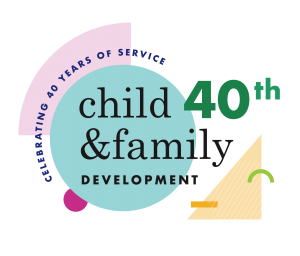By Kelly Conner, CCC-SLP ~ Child and Family Development
As a speech language pathologist that works with little ones, some of the most common questions I get from parents is “when will my child start talking?” A child’s first words are some of the most rewarding milestones, and there is a lot that needs to happen before a child will start using words.
Pre-Linguistic Skills
Before a child begins to talk, they need to develop a foundation for language development, called pre-linguistics skills. Pre-linguistic skills are non-verbal ways of communicating that help a child develop their first words. Most of these skills are naturally present in a baby’s daily routine. There are many ways to practice these skills with your child to build a strong foundation for communication and language development.
Eye Contact
Eye contact is so important to developing language because it shows engagement and allows you to gain knowledge about the world. By making eye contact you can learn about one’s emotions, develop relationships and connections, and better attend to what others are saying. Babies begin to develop eye contact with caregivers at around 6-10 weeks and then continue to further their eye gaze skills in the following months by following a caregiver’s gaze.
Ways to work on eye contact:
1. Get on their level. Position yourself at your child’s level and hold toys/objects around 10-20 inches away from your face. Being face-to-face with your baby makes eye contact easier.
2. Play Peek-a-Boo and sing songs. Simple interactive games and songs encourages your baby to look at you. With peek-a-boo, your little one will be looking directly at your eyes. With other fun songs, such as “wheels on the bus” or “pat-a-cake”, pause the song and wait for your child to make eye contact before continuing.
3. Talk during daily routines. When completing daily routines such as bath time or meal time, have a conversation with your child. Talk to them, and use their eye gaze as a response to keep talking or sharing. Use these times to regularly connect with your baby.
Joint Attention/Pointing
Joint attention is when two people are focusing on the same thing together. It is one of the best ways to play with little ones. As mom plays with a ball, baby becomes interested in it too and play catch. This can also be seen in the reverse; your young one may look out the window for the millionth time pointing to the dog outside, and you get excited with them about the same animal you see twelve times a day. Being able to focus together on an object through eye gaze, pointing, or vocalizations helps develop attention.
Ways to work on joint attention:
1. Engage in a highly motivating activity. Every child has that one thing they could do all day such as zooming a toy car around the house or look at the same book over and over again. These activities the child already loves is a great way to work on joint attention because they will already be attending to the object, so you can join in to encourage joint attention.
2. Pay attention to where your child is looking. When your baby seems fascinated by something or keeps referring back to it, engage in that by making comments and directing your attention to that same activity. Encourage your child to point to what they are interested.
3. Draw attention to what you are doing. To get your child to pay attention to you, make comments and use tone of voice to get them interested in you and what you are doing. Narrate what you are doing, or what your child is doing, using simple sentences.
Turn Taking
Turn taking is essential to holding a conversation, playing a game, and many other social routines in which you use language. We use turn taking constantly in our everyday lives. Some kiddos learn turn taking easily, while other may need more direct teaching of how to take turns.
Ways to work on turn taking:
1. Label whose turn it is while playing. When engaging in turn taking activities such as building blocks or playing with toys that have buttons, talk through the turn taking process. Point to yourself and say “my turn” before completing the action, and then point to your child and say “your turn.”
2. Use everyday objects. Anything can be turned into a turn taking routine. If your baby drops a toy off their high chair to the floor, day “uh-oh” and pick it up; they will likely drop it again. This can be a great opportunity to take turns as they drop and you pick up. You can also take turns cleaning up, pretending to feed each other, etc.
3. Control items to encourage participation. When playing with your child you can ensure turn taking by taking all the items. When doing a puzzle or a shape toy, keep all the pieces and they have to look at you or reach to indicate they want a turn. If they throw you a ball, keep it and wait for them to point or vocalize that they want it back.
Imitation
Little ones copy a lot in their environment; animal noises, simple sounds, actions. As a child begins to copy simple gestures like waving bye or clapping hands, they learn to communicate more effectively. Using imitation of sounds and common words helps bridge the gap between babbling and talking.
Ways to work on imitation:
1. Engage in fun gesture routines. There a tons of different gesture routines to teach your child. One of the most common is “so big!” where your little one reminds you of just how quickly they are growing up. Other gesture routines include waving hello and bye, clapping hands, and peek-a-boo. Some kiddos may need you to physically help them complete the gesture at first.
2. Engage in vocal routines. Encourage your child to make noise through back and forth copying activities. Smack your lips or blow raspberries. Make animal noises or car noises when playing. You can also encourage imitation of vowels sounds or early words (mama, dada). It is important kids see you make the noise many times before they begin to imitate.
These are some of the pre-linguistic skills a child needs to develop before beginning to say their first words. It seems like a lot, but think about how many of these you already do with your little one. The most important factor is to engage with your child as much as possible. Talk to them, play with them, teach them. You can cherish the time with your baby before they get too big, and help them develop a strong foundation for language and speech.
Kelly Conner, CCC-SLP is a Licensed Speech Language Pathologist at Child & Family Development. Our office provide services to children with developmental, neurological and congenital impairments. Services can be habilitative (learning a skill for the first time) or rehabilitative (becoming proficient at a skill or relearning a skill). We focus on a child’s ability to enjoy and interact with his environment. Typical focus areas include communication, articulation, auditory processing, voice/fluency and oral movements for speech and eating. Schedule a free phone consultation with a Speech-Language Pathologist. We are open and offering services in-office and virtual office visits for some services.
Child & Family Development

Locations:
Mitdtown:
4012 Park Road, Suite 200
Charlotte, NC 28209
704.332.4834
Pineville:
11940 Carolina Place Parkway, Suite 200
Charlotte, NC 28134
704.541.9080
Website | Facebook | Instagram | Twitter




